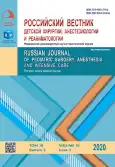Anesthesia for surgery in a patient with Knist's dysplasia for severe scoliotic deformity
- Authors: Smirnov I.V.1, Rojtberg G.E.1,2, Tsypin L.E.1, Lazarev V.V.1
-
Affiliations:
- Pirogov Russian National Research Medical University
- Clinic “Medicine”
- Issue: Vol 10, No 3 (2020)
- Pages: 299-308
- Section: Case reports
- URL: https://journals.rcsi.science/2219-4061/article/view/122918
- DOI: https://doi.org/10.17816/psaic642
- ID: 122918
Cite item
Full Text
Abstract
Kniest dysplasia is a disease that is inherited in an autosomal dominant manner. It manifests itself as dwarfism, scoliotic deformity of the spine, impaired joint mobility, muscle weakness, visual impairment, and sensorineural deafness. As a result of disproportionate trunk shortening, lumbar hyperlordosis and kyphoscoliosis develop, leading to internal organs (respiratory, cardiovascular system) disorders, disability, and reduced life expectancy.
A case of surgical treatment of a patient with Kniest dysplasia for severe kyphoscoliotic spinal deformity is described. Posterior corrective cross-rod transpediculocorporal screw spondylodesis T3-L5 with bone autoplasty was performed. While planning anesthesia, difficult tracheal intubation was evaluated on the LEMON scale of 7 points high-risk. While performing tracheal intubation, endoscopic techniques were used: videolaryngoscope, intubation bronchoscope, enabling success. Management of intraoperative blood loss was conducted by a complex of measures: laying the patient in the prone position with the release of the abdominal cavity, normothermia, intraoperative hemodilution of azlactone-balanced polyionic solutions to achieve the target hematocrit in the range of 24%–26%, and controlled hypotension with blood pressure decreased by 30% from the original hardware blood reinfusion during surgery. Also, on the first postoperative day, fusing tranexamic acid, correcting anemia and deficiency of blood coagulation factors donor components contributed to the success.
Discussion. When planning surgery and anesthesia, it is necessary to consider the risk of developing malignant hyperthermia, predicting difficult intubation, and complying with the algorithm to ensure airway patency and prevent massive intraoperative blood loss. With a comprehensive approach to patient management, it is possible to achieve rapid rehabilitation and discharge for outpatient treatment. Surgical treatment for rapidly progressing severe kyphoscoliathical spinal deformity can change the quality and duration of life in patients with Kniest syndrome.
Full Text
##article.viewOnOriginalSite##About the authors
Igor V. Smirnov
Pirogov Russian National Research Medical University
Author for correspondence.
Email: smirnov@medicina.ru
ORCID iD: 0000-0002-5348-3400
Anesthesiologist, Head of intensive care
Russian Federation, MoscowGrigorij E. Rojtberg
Pirogov Russian National Research Medical University; Clinic “Medicine”
Email: contact@medicina.ru
ORCID iD: 0000-0003-0514-9114
Dr. Sci. (Med.), Professor, Academician of Russian Academy of Science, Head of the Department of therapy and family medicine; President of the clinic “Medicinа”
Russian Federation, MoscowLeonid E. Tsypin
Pirogov Russian National Research Medical University
Email: 1dca@mail.ru
ORCID iD: 0000-0002-3114-8759
Dr. Sci. (Med.), Professor of Children Anesthesiology and Intensive Care Department with Professional Development Unit
Russian Federation, MoscowVladimir V. Lazarev
Pirogov Russian National Research Medical University
Email: 1dca@mail.ru
ORCID iD: 0000-0001-8417-3555
SPIN-code: 4414-0677
Dr. Sci (Med), Professor, head of Department of pediatric anesthesiology and intensive therapy
Russian Federation, MoscowSupplementary files











